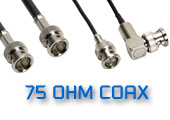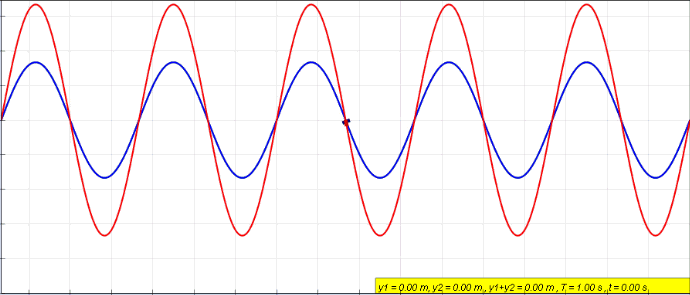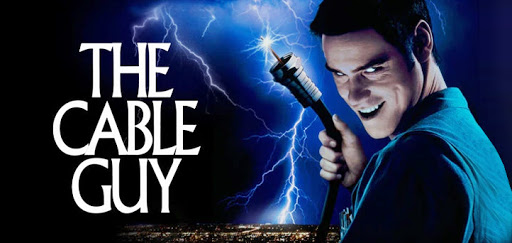This week’s question comes to us from Dan in Oregon: What is the difference between 50 Ohm and 75 Ohm Coax?


Hi Dan, thank you for this excellent question. This topic comes up quite frequently because a vast majority of electronics manufacturers fail to adequately explain the difference between the two types of coax and precisely why their equipment needs one type over the other. I will try my best to define some of the most critical concepts regarding coaxial cable technology — no engineering background required.
First, we need to define what an Ohm is and what exactly it measures. An Ohm is a unit of resistance — that is the resistance to the flow of electrical current through a circuit. In the most basic applications, where we are dealing with DC or Direct Current electricity, such as that from a typical 12-volt car battery, we are measuring the resistance in Ohms. However, the second we try and send AC or Alternating Current through a circuit, we are no longer measuring resistance, we are measuring impedance.
Alternating Current (AC) is more complex because it is not merely the magnitude (relative strength) of the signal that is being assessed, but the phase of the signal as well. An AC signal (waveform) is constantly switching its phase between negative and positive a certain number of times per second. For regular 120-volt house electricity, it changes phase 60 times per second. This is often abbreviated as 60 Hz.
The complex relationship between this magnitude and phase means that an AC circuit’s impedance consists of 3 essential components that are resisting the flow of the alternating electrical current. The first is resistance, which we just mentioned. The second two components are comprised of the circuit’s inductance and capacitance. Inductance essentially measures voltage(s) that are induced (created) in the circuit from the electrical current’s magnetic field. Capacitance effectively measures the electric charge that is stored in the circuit from the presence of these voltage(s). The combination of the circuit’s inductance and capacitance together is called reactance.
It’s not just household power that operates using AC — practically everything in our tech-driven society uses Alternating Current in the form of Radio Frequency (RF) energy. Your favorite AM radio station operates at a frequency of around 1 MegaHertz (MHz) or 1-million cycles per second. Your cell phone may operate at 900 MHz or 900-million cycles per second. To properly transmit these high-frequency RF signals, you have to have a medium of some sort that can deal with the complex interaction of resistance, inductance and capacitance. In most cases, we utilize coaxial cable.
Coaxial cable is comprised of three main components. In the middle of the coaxial cable is what is known as the center conductor. It can be made of either solid or stranded wire and is typically a mix of Aluminum and Copper. Surrounding the center conductor is something called the dielectric. The dielectric acts as a buffer of sorts to keep the center conductor isolated and straight. It usually is comprised of some blend of plastic and/or foam. Finally, on the outside of the dielectric is the coaxial cable’s shield, which is usually a combination of Copper and Aluminum foil and/or wire braid. The shield is then coated by something like PVC to insulate it from the environment.
 |
| Coaxial Cable Cutaway (Source: Wikipedia) |
Now, not all coaxial cable is created equal and that is where the coaxial cable impedance comes into play. It is the coaxial cable’s physical characteristics that will determine its impedance. According to Wikipedia, “The characteristic impedance of the coaxial cable (in Ohms) is determined by the dielectric constant of the inner insulator and the radii of the inner and outer conductors.” The cutaway drawing above is helpful in visualizing these characteristics. With these details in mind, over time, the industry settled on two characteristic coaxial cable impedances for the vast majority of applications (>90%): 50 Ohm and 75 Ohm.
First, let’s look at 50 Ohm Coaxial Cables. Experimentation in the early 20th century determined that the best POWER HANDLING capability could be achieved by using 30 Ohm Coaxial Cable, whereas the lowest signal ATTENUATION (LOSS) could be achieved by using 77 Ohm Coaxial Cable. However, there are few dielectric materials suitable for use in a coaxial cable to support 30 Ohm impedance. Thus, 50 Ohm Coaxial Cable was selected as the ideal compromise; offering high power handling AND low attenuation characteristics.
With 50 Ohm Coaxial Cables being the best compromise solution, practically any application that demands high power handling capacity, i.e. 100 watts or more, will use 50 Ohm Coaxial Cable. A good rule of thumb is that any device that functions as a transmitter or transceiver tends to use 50 Ohm Coaxial Cable. This includes devices such as CB/Ham/Marine Radios, Police/Fire/EMS Communications, Broadcast Radio/TV Transmitters, Wi-Fi/Cellular/4G/5G Systems and 2-Way Radios (Walkie Talkies).
At Amphenol Cables on Demand (www.CablesOnDemand.com), we offer a plethora of 50 Ohm Coaxial Cable solutions in the form of Coaxial (RF) Cable Assemblies — available in pre-fabricated lengths of military-grade (MIL-C-17) coax, precision-terminated to your choice of popular 50-Ohm RF Connector types, including BNC, Type N, SMA, UHF (PL-259), SMA to BNC, RP-SMA to N, RP-SMA , RP-TNC to N and RP-TNC.
We offer our Coaxial Cables in some of the most prevalent 50-Ohm “RG” MIL-SPEC styles to suit nearly any sort of application. RG-58 Coaxial Cable is perhaps our most popular “gold standard” 50 Ohm Coaxial Cable product, because it provides acceptable power/loss (1KW @ 10MHz) performance for most applications at a very low price. Not all RG58 is created equal, however. Our 5GHz rated RG-58C/U features lower return loss and signal isolation with its novel Double-Shielded 95% Copper Braid over 100% Aluminum Foil design.
Our next most popular 50-Ohm Coax is our 6GHz rated RG-174 Coaxial Cable. RG174 is great because it is so thin and flexible, i.e. 1/10th of an inch (2.54mm OD), allowing it to be used in real tight spaces such as feeding an antenna into a vehicle. RG174/U is a great choice for compact, man-portable and field-deployable HF/VHF antenna installations. It features 90% tinned copper braid shielding with a stranded copper-coated steel center conductor for up to 350W power handling despite it being “micro coax”.
For customers that want the absolute lowest attenuation and highest power handling capacity in a 50-Ohm Coaxial Cable (2700W RMS), RG-213 Coaxial Cable is the way to go. RG213 is our thickest coaxial cable at nearly half an inch in outer diameter (OD), thanks to its large 13-AWG Solid Copper Center Conductor and 96% Copper Braid Shield. RG213/U is the superior MIL-SPEC standard designed to replace its RG8 (RG-8/U) predecessor at frequencies well into the microwave/satellite range (11 GHz).
For unique situations in which the cables must withstand extreme temperatures (i.e. up to 200 degrees Celcius), such as automotive, rail, military and aerospace applications, we offer PTFE Teflon insulated coaxial cable products like RG-142 Coaxial Cables, RG-188 Coaxial Cables and RG-316 Coaxial Cables. These high-temperature rated coaxial cable offerings can handle extreme swings in temperature time and time again, such as those experienced when a plane takes off, ascends to 30,000 feet and then descends to land repeatedly.
However, not every case warrants high power handling, so 50 Ohm Coaxial Cable is not appropriate for every application. When the objective is to ensure that the signal gets through the cable in the most efficient way possible, losing very little signal strength in the process and avoiding signal delay distortions, 75 Ohm Coaxial Cable is the way to go. A good rule of thumb is that if the device being connected via coaxial cable is a Receiver/Tuner and NOT a Transmitter of some kind, 75 Ohm Coax is ideal. This includes devices such as Digital Satellite and Cable TV Boxes, High-Definition TV’s and Projectors, AM/FM Radio Receivers, Surveillance Systems and Police Scanners.
Another interesting application for 75 Ohm Coaxial Cable is Coaxial Digital Audio. This is the orange or black colored RCA jack commonly seen on HDTV’s, BluRay Disc Players and other Home Theater Gear. It is sometimes labeled as S/PDIF Out. It transfers the 5.1 Channel Dolby Digital Surround Sound signal to the home theater system for decoding and playback into the various speakers. Digital signals generally look like a square wave instead of the typical sine wave seen with analog signals like AC power or analog radio/TV.
The so-called “enemy” of a square wave digital signal is capacitance (remember this one?). This is because increased capacitance tends to “store” the peaks of the square waves, skewing the shape of the square to look more like a straight line. When this happens, the receiver has trouble reconstructing the signal after it has traveled down the coax. Technically 93 Ohm Coaxial Cable has the lowest capacitance of any type, but 93 Ohm Coax is rare and expensive. Thus, 75 Ohm Coax is the closest fit, offering not only low signal attenuation (loss), but also relatively low capacitance.
This combination of low attenuation and capacitance effectively make 75 Ohm Coaxial Cable the cable of choice for practically all types of digital audio, digital video and data signals. This is why every cable TV company uses 75 Ohm coax for distributing its digital video channels as well as its broadband internet data signals. Direct broadcast satellite dishes and over-the-air HDTV antennas also require 75 Ohm Coaxial Cable to ensure that all of the digital channels transfer down the cable with the lowest loss and distortion possible.
While we do not offer the typical RG-6 Coaxial Cable with Type F Connectors used for cable and satellite TV applications, we do offer an alternative RG-59B/U (Solid) Coaxial Cable with Type F Connectors line-up capable of handling all OTA, Digital Cable and Down-Converted Satellite (up to 1.25GHz) signals. Our RG59 Coaxial Cables with BNC Connectors feature special 75-Ohm rated BNC Connectors using flexible RG-59/U stranded coax, making them ideal for CCTV Surveillance, Medical Imaging (i.e. Endoscopy) and Professional Broadcast/Camera Equipment, including Serial Digital Interface (SDI).
Finally, one last crucial point in regards to coaxial cables. The Impedance of the various devices being connected as well as the Coaxial Cable itself must match. So if you are, for instance, connecting a 75 Ohm video camera connection to a studio monitor, the coaxial cable must also be 75 Ohm AND the connectors on the coaxial cable (i.e. BNC connectors) must be 75 Ohm in Impedance. Every single time you have a mismatch in impedance, say between a 50 Ohm Coaxial Cable and a 75 Ohm Coaxial Connector (i.e. BNC), a standing wave develops.

A standing wave is a signal reflection that is essentially wasted. Every time a 50 and 75 Ohm Impedance mismatch occurs, about 5% of the signal is lost. These losses add up and can eventually degrade the signal to the point that it is unrecoverable or distorted. Some coaxial cable manufacturers will cut corners in this regard. The BNC connector, described above, was invented by our parent company, Amphenol, before World War 2. It is extremely popular, but most people don’t realize that they come in two versions: 50 Ohm and 75 Ohm. All of our coaxial cables at Cables on Demand always have the proper impedance matched connectors to line up with the coaxial cable being used.
One can view our entire selection of Coaxial Cable products at Cables on Demand by visiting our website (www.CablesOnDemand.com). I hope this blog post helped clarify any questions you may have regarding coaxial cable impedance and types. If you have any further questions, please don’t hesitate to contact us at: cablesondemandblog@gmail.com.
Sincerely,
“The Cable Guy“

Product Marketing Manager
Amphenol Cables on Demand
Nick "The Cable Guy" Blas has enjoyed a fulfilling career as Amphenol Cables on Demand's exclusive Product Manager and resident tech expert, having worked for the company just months after its debut launch in December of 2006. Prior to Amphenol, Mr. Blas worked for another interconnect giant, Deutsch Connectors (Now Tyco), in their Defense and Aerospace division as their youngest Program Manager at just 25. While in college for Electrical Engineering and Business Administration/Information Management at UC Riverside and Cal State San Bernardino, Mr. Blas excelled in retail marketing management and sales for Canon USA and Hewlett Packard, both in their printer and imaging business units. Mr. Blas has been a self-professed "tech nerd" since age 10, with a particular fascination with radio and broadcast communications and antenna systems, which led to his college grant work for TRW Corp. Mr. Blas earned his Executive MBA at California State University, Monterey in 2012. He and his wife, Shelly and son, Ethan, currently reside in the stunning Ozark mountains, just outside of Bentonville, Arkansas (home of the world's largest company, Wal-Mart).